As prices rise in Logan Square, Humboldt Park fights gentrification
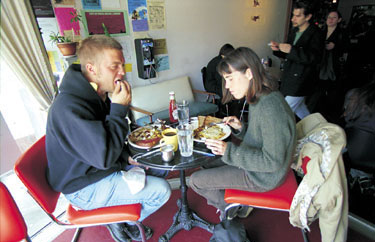 Lula Café is nearly full at lunchtime, but about half of the tables are taken by people eating alone. Some are working on crossword puzzles or reading the paper, a couple of others seem to be studying or writing poetry. It is the prototypical urban café. Abstract art hangs on the walls, and drum-heavy world music is piped through speakers, a man crooning in an African language. The wall near the payphone is plastered with posters advertising upcoming theater, dance and music events. The coffee is gourmet and the menu includes everything from sandwiches to Moroccan chickpeas with cous cous. The crowd is uniformly young, hip and white, and on this day includes at least two musicians.
Lula Café is nearly full at lunchtime, but about half of the tables are taken by people eating alone. Some are working on crossword puzzles or reading the paper, a couple of others seem to be studying or writing poetry. It is the prototypical urban café. Abstract art hangs on the walls, and drum-heavy world music is piped through speakers, a man crooning in an African language. The wall near the payphone is plastered with posters advertising upcoming theater, dance and music events. The coffee is gourmet and the menu includes everything from sandwiches to Moroccan chickpeas with cous cous. The crowd is uniformly young, hip and white, and on this day includes at least two musicians.
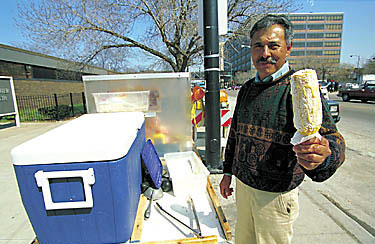 One is Eric Noden, a talented blues guitarist and singer who moved to Humboldt Park in October. He says there isn’t a coffeehouse like this in his new neighborhood, a largely Puerto Rican community directly south, so he has made the trip to Lula Café in Logan Square for breakfast.
One is Eric Noden, a talented blues guitarist and singer who moved to Humboldt Park in October. He says there isn’t a coffeehouse like this in his new neighborhood, a largely Puerto Rican community directly south, so he has made the trip to Lula Café in Logan Square for breakfast.
“There’s not too much around Humboldt, as far as hangout places,” Noden says. “Usually I come here to Logan or Wicker Park.”
He moved to Humboldt Park because he found a spacious three-bedroom apartment in a nice two-flat for $600, the same amount he was paying for a cramped two-bedroom basement apartment in trendy Roscoe Village.
Five years ago, young artists like Noden in search of big space and dirt-cheap rent often moved to Logan Square, a mostly Latino neighborhood bounded roughly by Western, Armitage, Diversey and Pulaski. The area had a big stock of beautiful old flats with low rents. There were few amenities of the kind they liked, but Bucktown and Wicker Park, next door, were full of artsy bars, coffee shops, restaurants and record stores.
Today, bargain rents are the exception, not the rule, in Logan Square. People like Noden increasingly are moving to Humboldt Park for cheap rent and making the trip to Logan Square for coffee, eats and music. A handful of cheap and artsy places, not unlike the ones that popped up in Wicker Park during the ’80s, have opened in Logan Square – the latest front in the westward wedge of gentrification.
“You can definitely feel that (gentrification) is happening,” says Lea Tshilds, co-owner with Jason Hammel of Lula Café. “But you don’t feel it in the restaurant.”
She says that as one of a handful of restaurants in Logan Square not serving Latin food, Lula has done very well since it opened in the former location of Logan Beach, another café, in September.
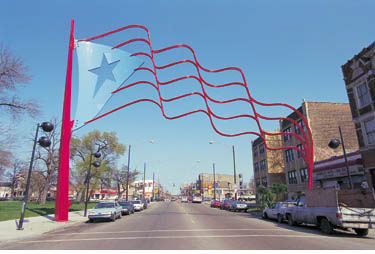 A customer with long black hair whom everyone calls Lou, but who insists his name is “Johnny Dollar,” says that Logan Square will not gentrify the way Wicker Park has.
A customer with long black hair whom everyone calls Lou, but who insists his name is “Johnny Dollar,” says that Logan Square will not gentrify the way Wicker Park has.
“This neighborhood has more of a middle class base – not a high influx of yuppies,” Johnny Dollar says. “There are a lot of families who have lived here for a long time. Well, there were in Wicker Park too, I guess, but they were pushed out. I doubt that will happen here.”
Mr. Dollar doesn’t say why the same process that sent property values through the roof in Bucktown and Wicker Park and caused large-scale displacement won’t occur in Logan Square, but he seems certain of it. He seems to know the neighborhood well and says he performs music at Lula on some weekends.
Towards the end of a conversation, though, he admits that he has lived in Logan Square for only six months. He moved there from Wicker Park in much the same way that the artsy types priced out of other neighborhoods moved to Wicker Park during the ’80s.
The westward push
Rising prices in Bucktown and Wicker Park have caused a growing number of renters, home buyers and developers to look at Logan Square. The neighborhood, in fact, is awash in a wave of condo conversions, and several upscale new construction developments – unheard of a few years ago in Logan – also are underway. A number of builders now market projects in Logan Square as being located in “West Bucktown.”
“Recently we’ve felt a lot of pressures from gentrification and displacement,” says Juan Rivera, executive director of the Latin United Community Housing Association, LUCHA. “A lot of people with more resources are coming in, especially in West Town and Logan Square. Humboldt Park is a little more stable.”
Rivera says that two- and three-bedroom apartments now renting for $800 to $1,000 a month in Logan Square went for $400 to $500 three or four years ago. The price and number of new condos also have risen sharply. About 300 condos were sold in Logan Square last year, nearly 127 percent more than during 1997, according to the Chicago Association of Realtors. By comparison, only eight condos changed hands in the neighborhood during 1993.
“It’s fair to say we haven’t done much over there until the last couple years,” says Jody Williams, of Jameson Realty Group, the marketing agent for a number of new developments in Logan Square. “I think it is an issue of pricing. Prices in Lincoln Park and DePaul and even Bucktown have been skyrocketing so much that you can just get a lot more bang for the buck in Logan Square.”
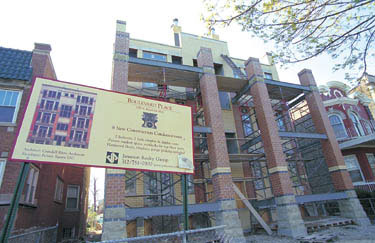 Jameson sales agent Barbara Buchel has lived in Logan Square, on Palmer Boulevard, for 17 years. She moved there from Lincoln Park after “falling in love with the architecture.” Both Logan Square and Humboldt Park are home to beautiful greystones and mansions and wide, grassy boulevards –remnants of the days when city planning was an art. Humboldt Park, which features a meandering lagoon and a number of stately buildings, is one of the city’s nicest. The square in Logan square, ornate with flower beds and decorative lighting, is capped with a soaring monument that looms in the distance as you drive west down stately Logan boulevard.
Jameson sales agent Barbara Buchel has lived in Logan Square, on Palmer Boulevard, for 17 years. She moved there from Lincoln Park after “falling in love with the architecture.” Both Logan Square and Humboldt Park are home to beautiful greystones and mansions and wide, grassy boulevards –remnants of the days when city planning was an art. Humboldt Park, which features a meandering lagoon and a number of stately buildings, is one of the city’s nicest. The square in Logan square, ornate with flower beds and decorative lighting, is capped with a soaring monument that looms in the distance as you drive west down stately Logan boulevard.
Buchel says that in Logan Square she sells to a large number of people moving to Chicago from out of town, as well as locals in search of more affordable pastures. But the pastures no longer offer the deals they once did. Prices on new condos in Logan Square are starting to catch up with those in Bucktown, according to Buchel.
“Condominiums here are only running maybe $20 to $25 a square foot less than in Bucktown, depending on the development,” Buchel says. “There are no more bargain days in Logan. We have little vacant land available, and the existing structures have such gorgeous architecture that you can’t knock them down.”
Buchel says developers scouring the neighborhood for buildings are willing to pay $80,000 to $115,000 per unit for old buildings to convert. After rehabbing the properties, builders are selling their condos for $180 to $220 a square foot. She recently sold out condo conversions at 1911 N. Humboldt, 2034 N. Humboldt and 2478 N. Kedzie totaling 35 units.
New construction also is gaining a toehold in Logan Square. In Boulevard Place, a newly constructed eight-unit building by Palmer Square Development Group, you can buy a 1,000-square-foot two-bedroom one-bath condo for $199,000. A two-bedroom two-bath unit with 1,450 square feet and a den costs $325,000.
Such projects are testing a new high-end in Logan Square and are wildly unaffordable to most residents. Despite rising property values and an influx of residents with more money, Logan Square remains a low-income community. According to the city’s 1995 estimate, the most recent available, the neighborhood is about 68 percent Latino. Many of the current residents came to Logan Square, which also has strong Polish roots, after being displaced from lakefront neighborhoods.
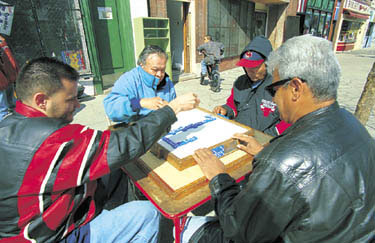 “There is an absolutely huge need for affordable housing there, both because in certain parts of the neighborhood the housing stock is not in great shape, and because in other parts, there is simply a complete lack of affordable housing because of the real estate market,” says Joy Aruguete, executive director of Bickerdike Redevelopment Corp., a non-profit group that develops affordable housing for rent and for sale in West Town, Humboldt Park and Logan Square. “The people being pushed out are people who have lived there generations. In Logan Square and East Humboldt Park, and even in West Humboldt Park, there’s no denying what’s going on. The community is gentrifying.”
“There is an absolutely huge need for affordable housing there, both because in certain parts of the neighborhood the housing stock is not in great shape, and because in other parts, there is simply a complete lack of affordable housing because of the real estate market,” says Joy Aruguete, executive director of Bickerdike Redevelopment Corp., a non-profit group that develops affordable housing for rent and for sale in West Town, Humboldt Park and Logan Square. “The people being pushed out are people who have lived there generations. In Logan Square and East Humboldt Park, and even in West Humboldt Park, there’s no denying what’s going on. The community is gentrifying.”
And private real estate transactions aren’t the only forces poised to push up property values in the area. In February, the City Council approved the Fullerton-Milwaukee Tax Increment Financing District, expected to raise $40 million in redevelopment funds during the next 23 years, according to Pete Scales, a spokesperson for the Department of Planning and Development. The TIF, a common tool used by the Daley administration to encourage development and boost the tax base in strategic spots, runs along Armitage from Ridgeway to Milwaukee, along Fullerton from Kimball to Francisco and along Milwaukee from Hermitage to School.
The TIF has been viewed as a mixed blessing in the community.
“There is no doubt that the city believes the TIF could be a useful vehicle in this environment, but many homeowners in the area are very concerned about its possible impact,” Aruguete says. “There are pluses and minuses to TIFs. For the last two years, if you’re building housing, it could bring in additional resources, but the concept is that you designate a TIF with the idea it will increase tax revenue.”
Hope in Humboldt
Boriken Bakery & Cafe, 2638 W. Division is not only in the heart of Humboldt Park, you might say it is the heart of the neighborhood.
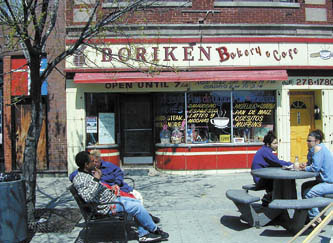 “Our motto is `Come for the food, stay for the conversation,'” says Zenaida Lopez, a community activist and owner of the bakery. “The design for the flag (across Division Street) was discussed in this bakery, and the façade program…On any given day there’s an alderman or state representative here.”
“Our motto is `Come for the food, stay for the conversation,'” says Zenaida Lopez, a community activist and owner of the bakery. “The design for the flag (across Division Street) was discussed in this bakery, and the façade program…On any given day there’s an alderman or state representative here.”
The café sits just east of the large iron Puerto Rican flag that stretches over Division Street. Boriken is quaint and comfortable, a couple of round tables, two easy chairs in the window and glass cases to display baked goods. A group of men play dominoes at a table outside, while Lopez works the counter. In addition to bakery items, the fare includes burgers, quesitos and Puerto Rican-style sandwiches with avocado, steak or chicken.
Lopez, who wears a baseball cap, green plaid pants and a sweatshirt, came to Chicago from Puerto Rico when she was seven years old. At that point, she says, there was only a small number of Puerto Ricans in Humboldt Park. In the late ’60s and early ’70s, a larger influx of people from Puerto Rico came to Chicago in search of work. Meanwhile, an earlier Latino community that lived on the Near North Side before being displaced to Lincoln Park was once again on the move.
“There was a large group in the early ’40s around Division and LaSalle, but once that area developed, we were displaced,” Lopez says. “Then we moved to Lincoln Park and were displaced from there. This is our last stop, the last trench.”
Lopez is quick to point out that the issue is not one of race, but of economics.
“A lot of people misunderstand,” she says. “It’s developers we’re worried about. I have a lot of progressive whites who are our customers and have lived here for a long time and care about the neighborhood. Our fear is that a Starbucks will open, that more people will be displaced.”
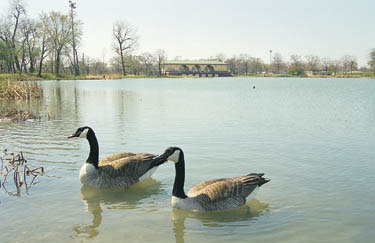 There is ample reason for such fear on the Near Northwest Side, but Lopez also sees hope for Humboldt Park. While prices have risen rapidly in Logan Square and in much of West Town, they have gone up much more moderately in Humboldt Park. There has been virtually no market for condominiums in the neighborhood. The Chicago Association of Realtors has not recorded a single condo transaction during the last two years in Humboldt, though some may have changed hands outside the system. In a real estate market full of double digit price increases, the average single-family house there has risen only about 8 percent during the last two years, to $86,000.
There is ample reason for such fear on the Near Northwest Side, but Lopez also sees hope for Humboldt Park. While prices have risen rapidly in Logan Square and in much of West Town, they have gone up much more moderately in Humboldt Park. There has been virtually no market for condominiums in the neighborhood. The Chicago Association of Realtors has not recorded a single condo transaction during the last two years in Humboldt, though some may have changed hands outside the system. In a real estate market full of double digit price increases, the average single-family house there has risen only about 8 percent during the last two years, to $86,000.
Even in gentrifying Logan Square, there are signs some buyers may be overpaying for condominiums. The median condo sold for $205,000 during 1998 in Logan Square, a nearly 25 percent increase over the year before, according to the Chicago Association of Realtors. But last year, the median condo price dropped more than 7 percent, to $189,900.
But perhaps most important, Lopez says, the community has learned from patterns of displacement in other neighborhoods.
“Gentrification displaces you,” Lopez says. “We didn’t have money or power before – we couldn’t control an area – so we kept moving. Now, politically, we’ve built a small power base and have raised the level of consciousness of residents.”
Groups such as LUCHA and Bickerdike also are working to preserve affordable housing. LUCHA recently received a commitment of $1.7 million in tax credits from the Chicago Department of Housing, which will allow it to raise $2.5 million to develop 30 units of affordable housing geared towards single mothers in Humboldt Park.
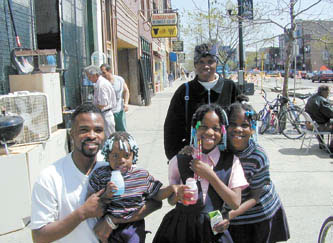 Initial plans for the project were controversial because they called for 49 units in one spot, to allow single mothers to share resources, such as childcare and transportation. Ald. Billy Ocasio (26th) opposed the concentration of units, though he had helped plan the project when he worked for LUCHA, before he became alderman. Rivera, executive director of LUCHA, says people concerned about concentrations of affordable housing in neighborhoods like Logan Square and Humboldt Park are missing the point.
Initial plans for the project were controversial because they called for 49 units in one spot, to allow single mothers to share resources, such as childcare and transportation. Ald. Billy Ocasio (26th) opposed the concentration of units, though he had helped plan the project when he worked for LUCHA, before he became alderman. Rivera, executive director of LUCHA, says people concerned about concentrations of affordable housing in neighborhoods like Logan Square and Humboldt Park are missing the point.
“When you talk about concentrations, it has to be relative to the need; you can’t talk about it in those sorts of terms,” Rivera says. “West Town, Humboldt Park and Logan Square have a large proportion of low- to moderate-income residents. The majority of the population in this neighborhood made less than 50 percent of the median income for the metropolitan area. If the majority of people makes less than 50 percent, the majority is in need of low-income housing.”
Ocasio now has agreed to LUCHA building on six scattered lots in his ward, with three apartments per lot, though he has yet to earmark specific parcels. Ald. Jesse Granato (1st) has designated four lots for the project. Local aldermen, including Vilma Colom (35th) and Ray Suarez (31st), as well as Ocasio and Granato, have mixed records on affordable housing, with some more supportive than others.
Bickerdike also has several affordable housing developments underway in the area. Buyers are lined up for 14 single-family homes and three owner-occupied two-flats under construction, and a 44-unit development of apartments with one to four bedrooms is scheduled for occupancy in the fall. The developer also is doing an 18-unit co-op and a 28-unit affordable condo conversion in Humboldt Park.
The city too has taken some measures to encourage affordable housing. The area around the park in Humboldt Park, from Augusta to North and Western to Central Park, has been declared a redevelopment area, allowing the city to use its powers of eminent domain to purchase 150 vacant lots. The city has issued a request for proposals on the property, and Aruguete says, Bickerdike has been asked to build 40 single-family homes in the zone.
“I think that there’s a more thoughtful approach by the broader community in those areas to say how do we slow the pace of gentrification and preserve the housing stock for people who want to live in the neighborhood,” Aruguete says. “Certainly the community has more experience under its belt. People are much more intentional about saying we have to have a preservation strategy, what will that look like? In Lincoln Park people batted their eyes and no one lived there any more.”
